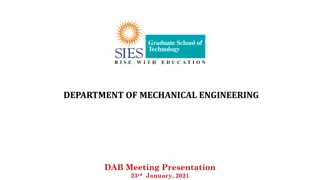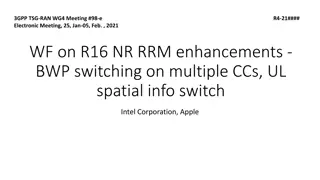
Testing Properties of Data in Finite-Sample Scenarios
Explore practical approaches for testing properties of data in finite-sample settings, focusing on hypotheses, minimax sense, and computational efficiency. Examples include assessing uniformity and bimodality in data distributions, with diverse testing methodologies and limitations discussed.
Download Presentation

Please find below an Image/Link to download the presentation.
The content on the website is provided AS IS for your information and personal use only. It may not be sold, licensed, or shared on other websites without obtaining consent from the author. If you encounter any issues during the download, it is possible that the publisher has removed the file from their server.
You are allowed to download the files provided on this website for personal or commercial use, subject to the condition that they are used lawfully. All files are the property of their respective owners.
The content on the website is provided AS IS for your information and personal use only. It may not be sold, licensed, or shared on other websites without obtaining consent from the author.
E N D
Presentation Transcript
DCE meeting (02/06/2021) Cl ment Canonne (Computer Science)
"Testing properties of data" Data = measurements, observations, output of a model (digital twin). Assume discrete for now. Property = pick your favourite model or assumption (unimodality/bimodality, shape assumption, parameterized family) Testing = (composite) hypothesis testing, minimax sense
"Testing properties of data" Data = measurements, observations, output of a model (digital twin). Assume discrete for now. Property = pick your favourite model or assumption (unimodality/bimodality, shape assumption, parameterized family) Testing = (composite) hypothesis testing, minimax sense, finite-sample Applications: model selection, density estimation, anything where hypothesis testing can be used
"Testing properties of data" Focus on finite-sample guarantees, non-asymptotic. Computationally efficient estimators (poly-time, or even near-linear time in sample size) Limitation: typically hard to give the explicit distribution of the test. (Also, not quite sure how that fits in the Bayesian framework.) Prototypical/most simple example: "given i.i.d. discrete observations from an unknown source, is the data uniformly distributed?"
A better example: bimodality Is the data distribution bimodal?
A better example: bimodality Is the data distribution bimodal? Many tests and approaches, many under strong assumptions (mixture models), some very na ve (compute some moment of skewness and kurtosis), some using fitting/density estimation.
A better example: bimodality Give a general algorithm (with finite-sample guarantees) for testing H : distribution is bimodal v. H : distribution at large statistical distance from every bimodal distribution Canonne, C.L., Diakonikolas, I., Gouleakis, T. et al. Testing Shape Restrictions of Discrete Distributions. Theory Comput Syst62, 4 62 (2018). https://doi.org/10.1007/s00224-017-9785-6
Why does it matter Pros: Fast, near-sample optimal, generalisable: applies to many other properties ("shape constraints"). E.g., monotone, unimodal, t-modal, log-concave, concave, convex, monotone hazard rate, t-piecewise degree-d distributions... Also performs density estimation as a side bonus, when H is not rejected. Cons: well, not actually implemented (just pseudocode)
Other similar tools Other general testing algorithm for Fourier-constrained models: can very efficiently test any property comprised of things with a sparse discrete Fourier transform. E.g., Poisson Binomial, sum of independent r.v's, log-concave Cl ment L. Canonne, Ilias Diakonikolas, and Alistair Stewart. 2018. Testing for families of distributions via the Fourier transform. In Proceedings of the 32nd International Conference on Neural Information Processing Systems (NIPS'18).
Why does it matter? Fast/efficient tools for model selection or hypothesis selection, which can be easily generalised: building blocks in a more complex system.
Why does it matter? Fast/efficient tools for model selection or hypothesis selection, which can be easily generalised: building blocks in a more complex system. Discrete data can be an issue...
Beyond discrete? Given continuous data or underlying quantities, how to measure/quantise them? With some specific goal in mind: say, density estimation or hypothesis testing (goodness-of-fit).
Quantization Optimal quantization for density estimation or goodness-of-fit testing for a fixed quantization budget: starting with discrete data (but too large domain) parameterized families (e.g., high-dim Gaussians*) continuous data (Sobolev or Besov classes) adaptive/nonadaptive settings Again, general "tools" and results. Joint works with Jayadev Acharya and Himanshu Tyagi + Yuhan Liu, Aditya Singh, Ziteng Sun, and Prathamesh Mayekar.
Summary Those "building blocks" can hopefully be helpful as components of larger systems . Techniques and ideas general by design, so ought to be extendable to other tasks of interest. (Sorry for the lack of nice pictures...)






















